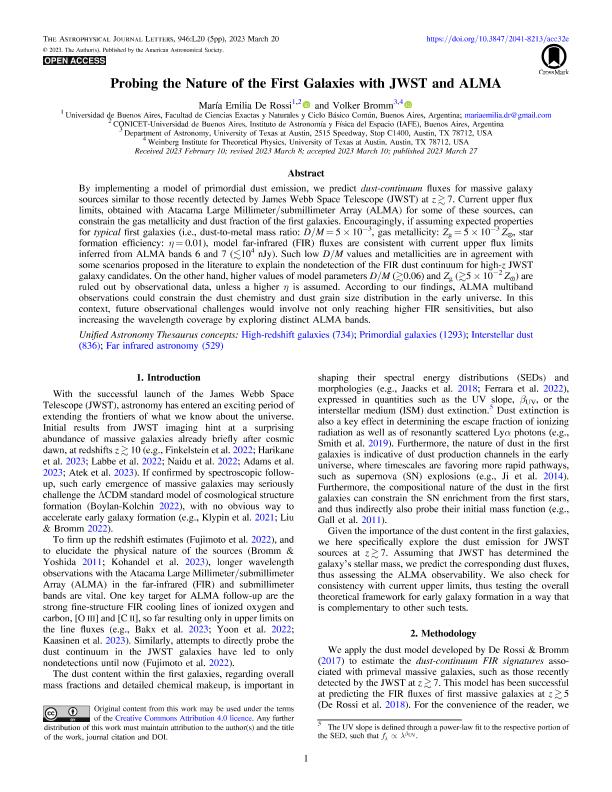Artículo
Probing the Nature of the First Galaxies with JWST and ALMA
Fecha de publicación:
03/2023
Editorial:
IOP Publishing
Revista:
Astrophysical Journal Letters
ISSN:
2041-8205
e-ISSN:
2041-8213
Idioma:
Inglés
Tipo de recurso:
Artículo publicado
Clasificación temática:
Resumen
By implementing a model of primordial dust emission, we predict dust-continuum fluxes for massive galaxy sources similar to those recently detected by James Webb Space Telescope (JWST) at z ≳ 7. Current upper flux limits, obtained with Atacama Large Millimeter/submillimeter Array (ALMA) for some of these sources, can constrain the gas metallicity and dust fraction of the first galaxies. Encouragingly, if assuming expected properties for typical first galaxies (i.e., dust-to-metal mass ratio: D/M = 5 × 10−3, gas metallicity: Z g = 5 × 10−3 Z ☉, star formation efficiency: η = 0.01), model far-infrared (FIR) fluxes are consistent with current upper flux limits inferred from ALMA bands 6 and 7 (≲104 nJy). Such low D/M values and metallicities are in agreement with some scenarios proposed in the literature to explain the nondetection of the FIR dust continuum for high-z JWST galaxy candidates. On the other hand, higher values of model parameters D/M (≳0.06) and Z g (≳5 × 10−2 Z ☉) are ruled out by observational data, unless a higher η is assumed. According to our findings, ALMA multiband observations could constrain the dust chemistry and dust grain size distribution in the early universe. In this context, future observational challenges would involve not only reaching higher FIR sensitivities, but also increasing the wavelength coverage by exploring distinct ALMA bands.
Archivos asociados
Licencia
Identificadores
Colecciones
Articulos(IAFE)
Articulos de INST.DE ASTRONOMIA Y FISICA DEL ESPACIO(I)
Articulos de INST.DE ASTRONOMIA Y FISICA DEL ESPACIO(I)
Citación
de Rossi, Maria Emilia; Bromm, Volker; Probing the Nature of the First Galaxies with JWST and ALMA; IOP Publishing; Astrophysical Journal Letters; 946; 1; 3-2023; 1-5
Compartir
Altmétricas




